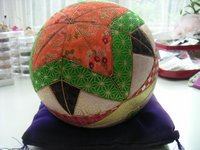


http://www2.nsknet.or.jp/~kid/mari1.html
http://www2.nsknet.or.jp/~kid/sakusei.html
先日、手まり糸について書きました。手まりは日本の伝統手芸の一つですが、丹念に糸をかがることで、繊細で幾何学的な美しい模様を作り出してきた日本人の手わざは素晴らしいものがあります。そのための糸が何色もいつも手芸店に常備されているのは、今も人気があるからなのでしょう。
私は手まり糸をもっぱらクレージーキルトに愛用しています。ポリエステルですが、柔らかでシルキーな光沢があり、ラメのものも複数あり、ちょっと使うととてもいいアクセントになります。ただ刺繍糸のように細い糸が複数本が撚ってあるわけではないので、その太さのまま一本の糸として使わなければなりません。撚りが緩くほどけやすいので、紐の房に使うこともあります。
写真の手まりは糸かがりではなく、木目込みで作ったもので、昔、人から頂いたものです。こういう布合わせや色合いはは私たちには見慣れたものですが、海外の方にはいかにもオリエンタルな布合わせに見えるのではないでしょうか。宮谷真知子さんの「はじめてのクレージーキルト」という本には、日本の古来の不定形な模様が、19世紀、西欧のシンメトリーを好む目に斬新に映り、ヴィクトリアンクレージーキルトに影響を与えたのだろう書かれています。同じ本に、上杉謙信の好んで着たというまさしくクレージーパッチと呼ぶしかない着物の写真が載っています。今年の大河ドラマ「功名が辻」、私はあまり熱心に見ているわけではないのですが、千代が、まだ山之内一豊の出世する前の貧しい新婚時代、古い着物を美しく継ぎ合わせて仕立てた斬新な小袖が人気を呼び、お市の方からも請われて縫った、というエピソードがありました。謙信とも同時代ですから、日本のクレージーパッチはその頃始まったのかも知れません。
Temari means a "hand ball". It's not a toy but a traditional Japanese handcraft ornament embellished beautifully by threads. You would see there Japanese artistic sense. To make temari seems to be a popular craft, for we can buy those threads very easily, while to find DMC rayon is hard. Though those threads are polyester today, they have so silky touch and softness I like to use them for CQ. They give very nice accent. There are many colors and lames in variety. The thread is a bit fat and we can't separate into strands.
The temari of the photos is not embellished by threads but fabrics. It's made in KIMEKOMI style, another Japanese craft.
Foreign CQers might see a crazypatched style in Oriental way there. In Machiko Miyatani(a Japanese wellknown CQer)'s book,I have read that Western people were so impressed by Japanese traditional not-symmetry patterns, they took the style into Victorian crazyquilting. She also introduces in the same book, a beautiful crazypatched kimono a famous Japanese lord, Kenshin Uesugi wore in the end of 16th century.
10 comments:
二つのハート確かに「和」を感じます。くすんだ赤色が郷愁を感じさせるのでしょうか。そういえばNHKの「純情きらり」の着物もそう。西洋的な3原色にはない、なんだか懐かしい色合いと柄と組み合わせ。昔々母がまだ普段着として着物を着ていた頃の雰囲気があって実はひとり懐かしんでおりました。
刺繍の本を眺めるだけで満足していた私ですが、見よう見まねで挑戦できそうな気がしてきました。ありがとう!
コメントありがとうございます。日本語入力も普通にできるのですね。「きらり」面白いですよね。冬吾さんの津軽弁、わかりますか?「はんかくさい」「ほじない」「まいね」「わらし」etc.
上のコメントは「ハート二つ」のところに書いたのですが、プレビューしてみたらなんと消えてしまっていて(操作ミス?)、こちらにもう一度同じような内容で書きました。だからちょっとズレていると思ったでしょ。「コメントするなんて緊張するぅ…」とこわごわだったのですよ。
津軽弁、「わらし」はわかるけどその他は??? もう少しわかると思ってたのだけど、はて。その昔電話局で働いていたときに、東北弁というと呼ばれては通訳してあげていたのだけれど。津軽弁は難しい。
I had heard of the influence of Japanese design on the west and how it influenced crazy quilting but I did not realise that designs date back to the 16th century - thanks for that little gem
Sharon,
I will send the photo from 16c to your personal address when I scan it.
The balls look beautiful,dear Hideko. Once I have folded orgigami with paper, and at the end of the lessons we tried such a ball. It was very difficult and the were not so nice as yours!
The Japanese arts are so diffrent from ours, they seems exotic to me and very attractive.
Ati from Norway.
Ati, thank you for visiting my blog. I would like to introduce our culture at times. I hope you will enjoy it. Hideko
Thanks, Hideko. I wish I knew about these threads when I lived there. Maybe next time. :-)
色についてです。秋のドイツを訪れたことがあります。飛行場からフランクルルトに向かう途中の美しい紅葉に「あっ、今乗ってきたルフトハンザと同じ色の黄色だ」と思わず声をあげました。そう、ドイツ国旗のあの黄色です。また、同じ秋の頃、と言っても地球の反対側では初夏の、オーストラリアに行ったことがあります。華やかな紫色の街路樹(ジャカランダ)の花が丁度日本の桜の花のように咲いていて、それは美しい光景でした。その時すぐに「この紫色はあのケン・ドーン(シドニー生まれのアーティスト・デザイナー)の色だ」と気づきました。同じ頃日本の山々は錦に染まります。赤あり黄あり緑あり、それぞれ違って美しく、一つずつでも、みんな集まってもさらに美しい錦色です。これが「和」の原点なのではないかと思ってしまいます。いつだって人は自然の美しさから何かをいただいてきましたから。
写真の手まりと手まり糸の美しい色をながめながらこんなことを考えていました。秋の京都、栗駒山きれいだろうなぁ、行きたいなぁと思いながら。
hideko
remember when I came back from my visit to Cowra and the magnificent display honouring the Japanese POW's held there- and how I was like a baby whose eyes had been opened- they displayed several types of Temari including the fabric and thread methods both methods were exquisite. I didnt realise though I should have that there were actually threads for making the Temari. I have enjoyed looking back on your blog today thank you very much
love n hugs bearxoxoxoxoxo
Post a Comment